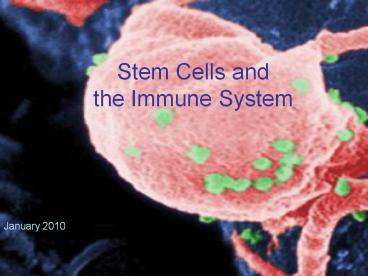Stem Cells and the Immune System - PowerPoint PPT Presentation
Title:
Stem Cells and the Immune System
Description:
... Natural Killer cells and macrophages Remaining cells can respond to secondary exposure Cytotoxic T cell binds to antigen on plasma membrane of target cells ... – PowerPoint PPT presentation
Number of Views:699
Avg rating:3.0/5.0
Title: Stem Cells and the Immune System
1
Stem Cells and the Immune System
- January 2010
2
Todays lecture
- Brainstorm
- Basic organization and function of the immune
system - Lymphocyte development
- Immune activation and response
- Immune suppression and tolerance
3
Todays lecture
- Brainstorm
- Basic organization and function of the immune
system - Lymphocyte development
- Immune activation and response
- Natural killer cells
4
Brainstorm
- Why do organisms contract diseases?
- What happens when an organism contracts a
disease? - What factors can help (or hinder) the likelihood
that we will contract a disease? - What happens when an organism is injured?
- What factors can help (or hinder) the likelihood
that we will recover from an injury?
5
Todays lecture
- Brainstorm
- Basic organization and function of the immune
system - Lymphocyte development
- Immune activation and response
- Natural Killer cells
6
Basic Organization and Function of the Immune
System
- The immune system is the bodys response to
disease and injury - Nonspecific response (innate immunity)
- Specific response (acquired immunity)
T-cell (part of the specific immune response)
7
Nonspecific response
- Exterior barriers
- Skin
- Mucous membranes
- Secretions
8
Nonspecific response
- Involves myeloid leukocytes (including all
phagocytic cells) such as macrophages - Participate in the inflammatory response to
injury or disease - Mast cells also involved
- Proteins (cytokines) signal between cells
mast cell
inflammation
protein
9
Specific Response
- Antigen-antibody relationship (acquired immunity)
- Vaccinations depend on this
- Involves lymphocytes (B, T and plasma cells)
Model of an antibody
T-cells, made visible by fluorescent dye
10
Todays lecture
- Brainstorm
- Basic organization and function of the immune
system - Lymphocyte development
- Immune activation and response
- Immune suppression and tolerance
11
Lymphocyte development
Gettyimages
Conceptualization of a lymphoid progenitor
cell
- Origin, Lineage, Functions
12
- Differentiation into lymphoid stem cells in the
bone marrow - General B cells mature in the bone marrow
- Differentiation into lymphoid stem cells in the
thymus - General T cells mature in the thymus
- Originates in
- bone marrow
- Rich supply of hematopoietic stem cells
- Asymmetric cell division (one daughter stays in
bone marrow ) - Lymphoid and Myeloid lineage cells begin and are
released from here
13
- Play
- The Cell is Right
- to learn about the blood tree
14
Migration
- Migration of mature general B and T cells to
secondary lymphoid organs - Lymph nodes
- Spleen
- Tonsils
- External body surfaces (intestinal, respiratory,
urinary, reproductive)
15
Todays lecture
- Brainstorm
- Basic organization and function of the immune
system - Lymphocyte development
- Immune activation and response
- Immune suppression and tolerance
16
Immune activation and response
What triggers these cells to respond?
- Antigen-antibody binding
- Structure, location and function of antibodies
- 1. Tag and disable antigen
- 2. Alert T cells, macrophages, leukocytes of
presence
17
Cell response
- B cells recognize antigens, proliferate and
produce specific antibodies. - Differentiate into plasma cells- to produce more
antibodies - Differentiate into memory cells- keep antibodies
in supply for activation from second encounter by
same antigen
18
- B cells recognize
- antigens,
proliferate,
and produce specific antibodies.
Differentiate into memory cells- keep some for
later
Differentiate into plasma cells- produce more
antibodies
19
Cell response
- T cells recognize and destroy tagged antigens
and proliferate - Cytotoxic T cells bind to antigen on plasma
membrane of target cells and directly destroy the
cells - Helper T cells activate B cells, cytotoxic T
cells, Natural Killer cells and macrophages - Remaining cells can respond to secondary exposure
20
Cytotoxic T cell binds to antigen on plasma
membrane of target cells and directly destroy the
cells
21
Helper T cells activate B cells, cytotoxic T
cells, natural killer cells and macrophages
22
Todays lecture
- Brainstorm
- Basic organization and function of the immune
system - Lymphocyte development
- Immune activation and response
- Immune suppression and tolerance
23
Why do stem cell transplants fail?
- Immune issues impact stem cell therapies
- Major Histocompatibility Complex is a persons
combination of cell surface proteins that
lymphocytes use to tell self from non-self - Allogeneic transplants fail because there isnt a
match, and lymphocytes destroy the non-self cells
24
Immune tolerance research
- Currently, transplant recipients need immune
suppression - giving drugs for long periods of
time to the patient - Dulls the immune response to non-self
- Increases susceptibility to disease
- Immune tolerance the future?
- Antigen-specific immune tolerance would use drugs
on the cell transplant to make them tolerogenic
25
Future of Immunotherapy
- Play video of Jeffrey Bluestone, UCSF































